Secrets of Hindu Marriage Traditions
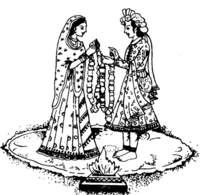 Hindu traditions are ancient and eternal too. But we the Indians fail to recognize our rich traditions while the foreigners are trying to learn about our traditions. Unless somebody else tells about our rich traditional treasure, we don’t even believe in it.
Hindu traditions are ancient and eternal too. But we the Indians fail to recognize our rich traditions while the foreigners are trying to learn about our traditions. Unless somebody else tells about our rich traditional treasure, we don’t even believe in it.
Marriage is not a celebration of a ceremony. Marriage is not all about exchange of rings or garlands. It’s all about a process of promising each other for leading a conjugal life. We never try to find the meaning of mantras chant by Purohits during the marriage process. These days, we just care for photos and videos and hardly pay any attention to the mantras, chant by purohits, since we feel it as the headache of purohit.
The Sanskrit word Vivah originated from three root sounds vi + vah + ghai which means “a very special dedication”.
Iyam Sita Mama Sutha, Sahadharmachari thapa Pratheechcha
Chainam Bhadram Thae Pannim Grihneeshwa Pa¯nina
According to Valmiki Ramayana - Maharaja Janaka tells Sri Rama while introducing his daughter Sita to Rama; that she is Sita his daughter, dedicating her to him and requests him to accept his daughter as his wife (better half).
A Hindu marriage joins two individuals for life, so that they can pursue dharma (duty), artha (possessions), kama (physical desires), and moksha (ultimate spiritual release) together. Hindu wedding ceremony at its core is essentially a Vedic yajna (a fire-sacrifice), It has a deep origin in the ancient ceremony of cementing the bonds of two families together.
The primary witness of a Hindu marriage is the fire-deity (or the Sacred Fire) Agni, and by law and tradition, no Hindu marriage is deemed complete unless seven encirclements have been made around Sacred Fire, by the bride and the groom together.
The love begins with the marriage for Indians, the love ends with the marriage for others as said by a poet.
The marriage procedures, their sanctity, their aim, the respectability they carry etc. can not be seen in any traditions in the world except in the holy land India as said by Madam Annie Besant.
The need of the marriage
Wife and husband are the two wheels of the life chariot. No one is superior to each other. Once they are married, they are not just two individuals, they are couple. Modern age life style brought personal egos and complexes into the lives. As long as there were no external influences, our traditions cherished.
|According to Hindu mythology everybody carries three debts right from his birth. They are
- Rishi Runam : Person has to learn Vedas (the sacred texts) means the knowledge which one has to acquire . To clear this owe, one has to pass on the knowledge he acquired from his gurus to his next generations.
- Deva Runam : We are indebted to Panchabhutas; the Sun for giving us the light, the Agni for giving us the fire, the Vayu for wind, the Varun for giving us water through rains, the Earth for giving us food we need. We need to clear this owe, by performing yajnas.
- Pithrunam : We are indebted to our beloved parents who given us the opportunity to come to this world by giving us the birth. We have the responsibility of continuing their vamsa (generation). To clear this owe one has to get married and continue the generations.
The sanctity of marriage is being lost. The culture is polluted by the adopted cultures.
The society tries to follow the iconic figures. For most of the common folk, cinema heroes and heroines are the iconic figures. These iconic figures have the responsibility of remaining as the role models to the society. Ironically, they are not able to shoulder such responsibilities. Male and female living together without any bond/marriage is one such adopted culture. One can’t totally deny the prevalence of such tendencies in our society earlier. Even if they are, they can be considered as sporadic. But when an iconic figure resorts to such acts, it definitely has its impact on the society.
The courts too becoming parties in polluting our cultures with the recent pronouncements legitimizing the practice of living together, marriage between homos/lesbians etc. There are hundreds and thousands of cases piled in different courts desperately looking for their turn to get justice, the courts are becoming very passionate these days to pronounce judgements on silly issues of this kind ignoring the cases which deserve their full attention.
The process of marriage largely packed with vedic mantras (chanted by purohits on behalf of bride and groom) is more of promises and faiths reposed on each other in the holy presence of Agni (fire).
Let us see the process of Hindu marriage in brief
Snathakam (Convocation) : Traditionally for the generations long, when the male child graduates, he decides to stay back in Kasi (also known as Varanasi-which considered as the abode of the almighty) to take up brahmacharya (the sainthood). During the sainthood he won’t take care of his hair and grows beard also. If he seeks sainthood, literally there is no chance of generation next. As such, the elders welcome the boy to family life. To mark the occasion, the grown hair and beard neatly cut and shaved and performs bath with hot water. This is what we call “Convocation”. This is the first step in the process of the marriage.
 Kasi Yatra : The father of bride symbolically weans him away from the pursuits of brahmacaryam, and requests him to enter family life (grihastasramam) by marrying his daughter. The bride's brother convinces the groom that there is life beyond education and by marrying his sister.
Kasi Yatra : The father of bride symbolically weans him away from the pursuits of brahmacaryam, and requests him to enter family life (grihastasramam) by marrying his daughter. The bride's brother convinces the groom that there is life beyond education and by marrying his sister.
Sankalpam: This is nothing but thought of doing something. While we offer prayer to god, we have to reveal our full identity in order to register our prayer. In this we reveal every minute details like the name of the land, time like name of the yuga, name of Manwantram, name of the year, name of the month, name of the day, name of Thithi, from which place the prayer being offered etc., details will be given along with the details of the performer of the pooja/prayer. Any pooja or celebrations will commence with Ganesh pooja for successful completion of such programme without any obstacle.
Ankurarpanam : The women, specifically the bride, sprinkle 9 different kinds of grains (Nava Dhanyalu) in earthen pots filled with wet mud, such that the grains sprout into green shoots in time. This is symbolic of the germination process of the human life for which the marriage itself is conducted. The soil used in the earthen pots is obtained from ant-hills due to its exceptional fertility characteristics.
Gowri Pooja : During this ritual the bride offers her prayers to invoke Goddess Gowri Devi, seek her blessings. Goddess Gowri Devi is the icon of an ideal wife. The Goddess’ own marriage is the symbol of ever-lasting love. Ardhanareeshwaram is the concept of the perfect emotional, mental and physical union between 'Gowri' and her divine husband ‘Lord Siva’. By invoking the Goddess’ blessings, the bride prays for similar strength and a long, happy, married life with her husband.
Kanyadanam : Groom will be considered as personification of Vishnu and pooja performed to him as is performed to the almighty. This is performed by the father of the bride. The following slokas are chanted.
Kanyam Kanaka Sampannam kanakabharanairyutham, Dashtami
Vishnave Thubhyam Brahmaloka Jigeeshiya.
Vishwambhara Sarvabhuta, Sakshinya Ssarvadevatha, Kanyamimam vradasyami, Pithrunam Dharanayavai.
Kanyam Sarvalankritham Sadhvim Suseelaya Sudheemathe Vrayatho ham prayachchami Dharmakamardha Siddhaye.
Dharmardha Kameshu Thwayesha, Nathi Charatavya, ---- Nathi Charami
The father of the bride offers his daughter who is bedecked in gold to the groom considering him as embodiment of Vishnu, the almighty with a belief that he and his past seven generations is blessed to abode in Brama Loka. The father of the bride also tells groom that the decorated bride, offered to the groom so that he can get children through her and do all his prescribed religious duties.
Sumuhurtham (Jeelakarra(cumin seeds)-bellam(jaggery) dharana)
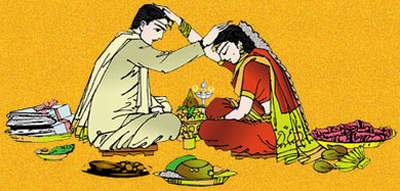 At the sumuhurtam, precise auspicious moment, with the cloth veil still upheld, the bride and the groom place and hold a paste made of cumin seeds and Jaggery, over each other's heads (on the crown of the head where the opening of Sushumna nadi through which Kundalini enters) The cloth veil is then removed, unveiling the "new' life in holy matrimony. This is the first time the bride and groom look at each other.
At the sumuhurtam, precise auspicious moment, with the cloth veil still upheld, the bride and the groom place and hold a paste made of cumin seeds and Jaggery, over each other's heads (on the crown of the head where the opening of Sushumna nadi through which Kundalini enters) The cloth veil is then removed, unveiling the "new' life in holy matrimony. This is the first time the bride and groom look at each other.
The mantra chanted at this moment is
Dhruvante Raja Varuno Dhruvam Devo Brihspathi
Dhruvantha Indraschaangischa Rashtram Dhrayatham Dhruvam.
Abhrathrughneem Varunapathighneem Brihaspathe
Indra Puthrighneem Lakshyam Thamasyai savithassuva
Why the cumin seeds and jaggery paste
Positive Electric charge emanates when cumin seeds and jaggery are combined and a paste made of it, as is happened when the glass rod rubbed with silk cloth (In the case of glass rod, electrons are loosely bounded compared to silk cloth and hence it loses electrons &get positive charge and it gets the ability to attract the nearby particles). In the crown of the head, a subtle or esoteric aperture will be there. When this paste is placed on the top of this esoteric aperture which remains closed, gets opened and the positive energy enters through this hole, it travels through Sahasrara Chakra reaches the Ajna Chakra and energizes it(centre of spiritual energy- placed between the two eyebrows otherwise called Bhrumadhya or Bhrukuti). The bride and groom when looks at each others Bhrukuti (when the veil removed/put down,) their brain wave lengths meet. When the wave lengths of two persons coincide, they think alike and there is no chance of contradictions. This gives them the pleasurable married life.
Yoktra Dharana (Tying of rope made of a kind of grass)
Here, the groom tie a rope made of Dharbha (a kind of grass) around the waist of the bride. Whenever we get ready to do a hard job we tie a cloth around our waist, which gives us extra strength duly protecting the spine. Here the groom prepares the bride to take up the new responsibilities in their marital life with ease. He does this by reciting the following prayer.Oh fire God; please give a stable and composed mind to this maid, who is going to join me and give her strength to take the extra responsibilities of the family. 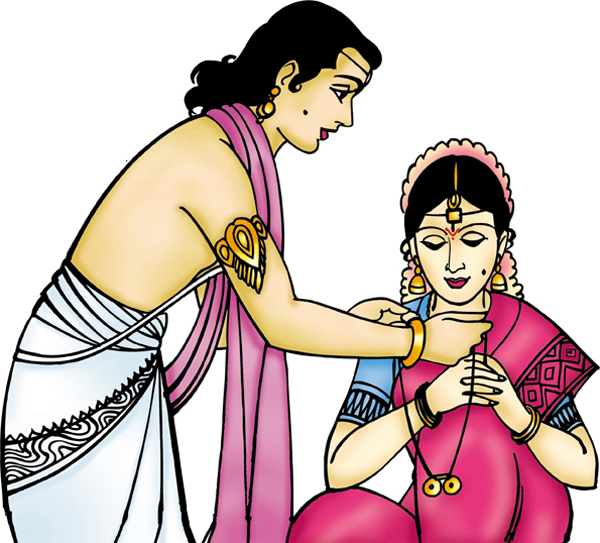
Mangalasuta Dharana (Tying of three knots)
Mangalya means that which gives good things and Dharanam means "wearing". The bride has to wear two mangalyas one given by her father and another by the groom's father. This is one of the most important events of a hindu marriage. The groom ties the mangalasutram, a sacred necklace with the mangalyam (two gold pendants) around the bride's neck. The sacred necklace symbolizes commitment, safety and security offered to the bride by the groom as he asks her to share in a long and happy married life with him. The groom secures the necklace by tying three knots. Each knot symbolizes each aspect of the body-- Sthula Sharira – Gross or Physical body, Sukshma Sharira – Subtle or Pranic body, Karana Sharira – Causal body. It also stands for the three aspects of commitment, manasa, vachaa, karmana, believing it, saying it and executing it. While groom ties the knots, the high priest chants the
Mangalya tantunanena mama jeevana hetunaa:
kanthe badhnami Subhage saa jeeva saradam satam
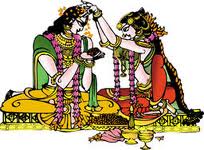
Talambralu
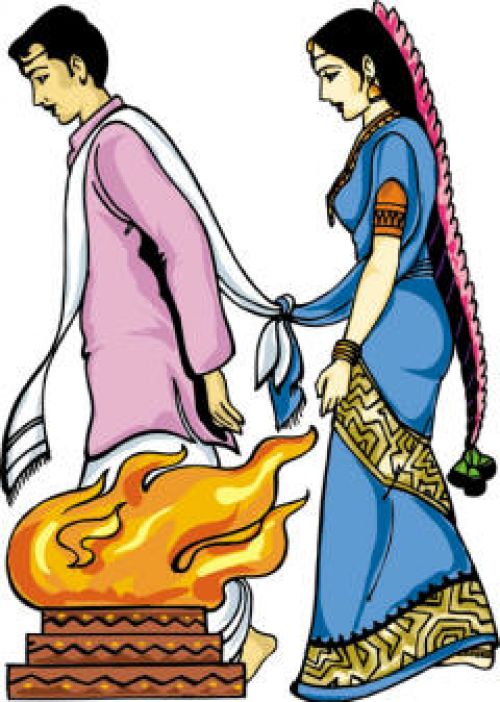 This is a fun event. Bride and Groom put Talambralu (Akshatalu) on each other. The bride and the groom shower one another with pearls & talambralu (rice mixed with saffron & turmeric). This denotes the couple’s desire for happiness, enjoyment and contentment. Initially they take turns to shower, as it progresses it gets more entertaining when they begin to compete with each other.
This is a fun event. Bride and Groom put Talambralu (Akshatalu) on each other. The bride and the groom shower one another with pearls & talambralu (rice mixed with saffron & turmeric). This denotes the couple’s desire for happiness, enjoyment and contentment. Initially they take turns to shower, as it progresses it gets more entertaining when they begin to compete with each other.
Homam (Holy fire)The holy fire, a great protection against evil, is believed to be a messenger and mediator between God and human. This fire acts as an eternal witness to marriage. The bride and groom pledge and declare to all those present that they have accepted one another voluntarily. Holding each other's hands, the couple takes seven steps, symbolic of the seven marital vows, around the sacred fire.
- Together, we will acquire energy to share responsibilities of our married life.
- Together,we will fill our hearts with strenght and courage to accmplish all the needs of our life.
- Together,we will prosper and share our worldly goods and will work for prosperity of our family.
- Together, we will chesrish each other in happiness and in sorrow.
- Together,we will raise dtromg and virtuous children.
- Together, we will fill our heartswith great joy, peace , happiness and spiritual values.
- Together, we will remain lifelong patners in the matrimony.
Nagavalli
During Nagavalli, a silk cloth cradle was made and a piece of sandalwood, a ripe mango/banana and turmeric was placed in it to pray for an off spring as healthy as the ripe mango, as pure as the turmeric and as self fragrant as the sandalwood.
This is followed by a fun filled event where the bride and groom fight over who will collect the gold and silver rings dropped in a narrow mouthed vessel.
Sannikallu (Grindstone)
Holding the bride’s left foot toe, the bridegroom then helps her tread on a grindstone called sannikallu kept on the side of the fire. The manthras say: "Mount up this stone. Let thy mind be rock-firm, unperturbed, by the trials and tribulations of life" and when it is finished, the groom adorns the bride's toes with mettelu, silver rings.
At this time the priest shows the couple the Arundhati star. Arundhati, the wife of vasistha maharshi (the great saint), is exemplified as an ideal wife, the embodiment of chastity. By seeking her blessings, the bride expresses her devotion toward family life.
Pani Grihanam (Vedic)
Literally this means "holding of hands. Because this is the first most important Vedic ritual, scholars believe that this should be done during the auspicious time. Normally the bride folds fingers her right hand fingers into a conical form upwards and the groom holds it in his hand folded downwards by surrounding all her fingers.
The following prayers are recited by the groom
Hey maid, I am holding your hand so that you will have several good children and live happily with me till ripe old age. Hey Goddess Lakshmi, you are blessed with all the luck, riches and food and so we who have held our hands today, hope to get riches and pleasures by your blessings. I announce this loudly in front of all so that you will definitely bless me. Hey Maid, Let Vayu (god of wind) who has the capacity to travel in all directions, who keeps a gold coin in his hand to give to those who pray him and who is the friend of fire God (Agni) who has the capacity to purify everything as well as the capacity to make raw food eatable, enter your mind and make you love me for every minute of our future lives.
Laja homamlaja Homam is a secondary post-wedding ceremony in which the priest lights a fire to which the newly married couple offer oblations of puffed rice or popped grains (Laja). This shall comprise the bride’s own offering to the sacrificial fire. He gives her a handful of parched rice grains which she hands to bridegroom who on her behalf, feeds it into the fire. Through this food offering, the bride seeks a long life for her husband, and propagation of the family. Participation of the bride’s family members indicates the continuance of links between the two families, even after marriage. The couple circle around the fire, three times, and the feeding of the fire with parched rice, is repeated thrice.
Removal of the Dharbha string tied earlier around the bride’s waist
The groom recites the following prayers and then unties the dharbha string he has tied earlier:
i. I free from the rope tied by Lord Parameshwara who ties this rope of Varuna for all the good-minded beings, I give you the position of pleasure with me to you in the world of Brahma.
ii. I free you form the string of Varuna tied by the Lord Parameshwara who gives blessings to his devotees. You can live with me in Brahma loka where the blessed go and be with me without the fear of the rope of Varuna.
I try to present the Hindu marriage tradition and processes in brief. I might have omitted certain processes because of certain constraints. In those golden (old) days of our forefathers, the marriages used to perform for 5 days giving detailed importance to each of the process. Today, we don’t have the resources and time because we have our own confinements, in our brisk lives to perform for so long time. But there is no reason in making mockery of the traditions. It is our duty to uphold the sanctity of our traditions. Let us try to know the importance of every process of marriage tradition. Demand your priest to narrate the secrets of the tradition while performing the marriage. It is our duty to know. Let us not kill our rich traditions.
-courtesy by suravajhala